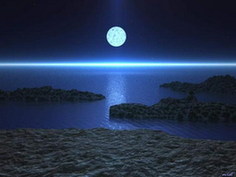天文學(xué)家表示,12月31日晚上,北美、歐洲和非洲國(guó)家的人們將看到本月的第二輪滿月,即人們所說(shuō)的“藍(lán)月”,而東半球的人們則有望觀賞到本年度最后一次月偏食。據(jù)科學(xué)家介紹,在天文歷法中,當(dāng)一個(gè)月出現(xiàn)兩次滿月時(shí),第二個(gè)滿月就被賦予一個(gè)充滿神秘浪漫色彩的名字——“藍(lán)月”(Blue Moon)。由于月運(yùn)周期(月亮繞地球一周)是29.5天,因此,大約每30個(gè)月就會(huì)出現(xiàn)一輪“藍(lán)月”。據(jù)悉,上一次出現(xiàn)“藍(lán)月”是在2007年的5月,而此次新年“藍(lán)月”則更為罕見(jiàn),科學(xué)家稱每19年我們才有機(jī)會(huì)在“藍(lán)月”的映照下迎來(lái)新的一年,下一次可就要等到2028年了。

 |
|
Once in a blue moon there is one on New Year's Eve. Revelers ringing in 2010 will be treated to a so-called blue moon. |
Once in a blue moon there is one on New Year's Eve. Revelers ringing in 2010 will be treated to a so-called blue moon. According to popular definition, a blue moon is the second full moon in a month. But don't expect it to be blue - the name has nothing to do with the color of our closest celestial neighbor.
A full moon occurred on December 2. It will appear again on Thursday in time for the New Year's countdown.
"If you're in Times Square, you'll see the full moon right above you. It's going to be that brilliant," said Jack Horkheimer, director emeritus of the Miami Space Transit Planetarium and host of a weekly astronomy TV show.
The New Year's Eve blue moon will be visible in the United States, Canada, Europe, South America and Africa. For partygoers in Australia and Asia, the full moon does not show up until New Year's Day, making January a blue moon month for them.
However, the Eastern Hemisphere can celebrate with a partial lunar eclipse on New Year's Eve when part of the moon enters the Earth's shadow. The eclipse will not be visible in the Americas.
A full moon occurs every 29.5 days, and most years have 12. On average, an extra full moon in a month - a blue moon - occurs every 2.5 years. The last time there was a lunar double take was in May 2007. New Year's Eve blue moons are rarer, occurring every 19 years. The last time was in 1990; the next one won't come again until 2028.
Blue moons have no astronomical significance, said Greg Laughlin, an astronomer at the University of California, Santa Cruz.
"`Blue moon' is just a name in the same sense as a `hunter's moon' or a `harvest moon,'" Laughlin said in an e-mail.
The popular definition of blue moon came about after a writer for Sky & Telescope magazine in 1946 misinterpreted the Maine Farmer's Almanac and labeled a blue moon as the second full moon in a month. In fact, the almanac defined a blue moon as the third full moon in a season with four full moons, not the usual three.
Though Sky & Telescope corrected the error decades later, the definition caught on. For purists, however, this New Year's Eve full moon doesn't even qualify as a blue moon. It's just the first full moon of the winter season.
In a tongue-in-cheek essay posted on the magazine's Web site this week, senior contributing editor Kelly Beatty wrote: "If skies are clear when I'm out celebrating, I'll take a peek at that brilliant orb as it rises over the Boston skyline to see if it's an icy shade of blue. Or maybe I'll just howl."
相關(guān)閱讀
(Agencies)

(英語(yǔ)點(diǎn)津 Helen 編輯)
